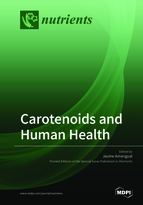Carotenoids and Human Health
A special issue of Nutrients (ISSN 2072-6643).
Deadline for manuscript submissions: closed (28 February 2019) | Viewed by 125974
Special Issue Editor
Special Issue Information
Dear Colleagues,
Carotenoids are a group or nearly 600 pigments, mostly synthetized by plants, and present in our daily diet in fruits and vegetables; however, they are also present in some animals, such as salmon and seafood. Carotenoids are also a target of the growing food supplement industry market, which is estimated to have a revenue of over $110 million/year (only in the US). Approximately 20 different carotenoids are present in human plasma, and some of these carotenoids and their derivatives, such as vitamin A, act as bioactive compounds regulating key physiological processes including vision, energy metabolism, embryo development, and cancer. To date, however, the role of most of these compounds has not been completely understood.
The aim of this Special Issue entitled “Carotenoids and Human Health” is to provide the scientific community with an updated perspective of this exciting and growing research field. We are currently in the process of calling for scientific reviews and original publications until 28 February, 2019. Manuscripts covering topics ranging from the molecular mechanisms of action of carotenoids and derivatives in animal models to human population studies or dietary interventions are invited to participate.
Prof. Jaume Amengual
Guest Editor
Manuscript Submission Information
Manuscripts should be submitted online at www.mdpi.com by registering and logging in to this website. Once you are registered, click here to go to the submission form. Manuscripts can be submitted until the deadline. All submissions that pass pre-check are peer-reviewed. Accepted papers will be published continuously in the journal (as soon as accepted) and will be listed together on the special issue website. Research articles, review articles as well as short communications are invited. For planned papers, a title and short abstract (about 100 words) can be sent to the Editorial Office for announcement on this website.
Submitted manuscripts should not have been published previously, nor be under consideration for publication elsewhere (except conference proceedings papers). All manuscripts are thoroughly refereed through a single-blind peer-review process. A guide for authors and other relevant information for submission of manuscripts is available on the Instructions for Authors page. Nutrients is an international peer-reviewed open access semimonthly journal published by MDPI.
Please visit the Instructions for Authors page before submitting a manuscript. The Article Processing Charge (APC) for publication in this open access journal is 2900 CHF (Swiss Francs). Submitted papers should be well formatted and use good English. Authors may use MDPI's English editing service prior to publication or during author revisions.
Keywords
- Carotenoids
- Apocarotenoids
- Vitamin A
- Nutrition
- Human health







